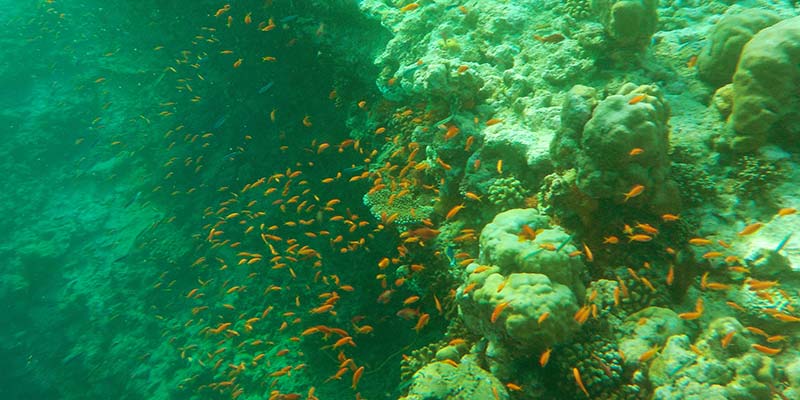Sue Parker blames the messenger for some disturbing news
News of the tragic death by food poisoning of a woman on honeymoon in Mexico last October worried me. She had been eating fish. But isn’t fish an important aspect of the world-famous Mediterranean Diet, key to good health and longevity?
In this instance the culprit was Ciguatera, an illness caused by eating large reef fish such as groupers. Alarm bells began ringing: groupers (garoupa) caught off our own shores are served in many Algarve restaurants. An internet search soon set my mind at rest – initially, at least.
Ciguatera seems to be a problem with tropical reef fish and in particular large ones such as groupers. The deadly toxin is actually made within the bodies of tiny dinoflagellates, marine plankton that cling to algae and seaweed, the staple food of small reef fish. Larger reef fish eat the small fish and so on up the food chain until all those toxins get concentrated in the bodies of big bullies such as groupers.
The bigger the fish the greater the concentration of toxin; so while a fillet from the flanks of a huge specimen might command a higher price, the eater might end up paying the ultimate price. There are no tests for this toxin … and no cure either.
One worry leads to another, and I got to thinking about other toxins known to accumulate in our sea fish. Mercury, a metal also known as quicksilver, is liquid at normal room temperatures and one of the deadliest toxins that collect in fish tissue.
So what is mercury? Well, it is the name of the innermost planet in our solar system, a hyperactive heavenly body making four circuits of the sun in less than one Earth year. The planet was named after Mercury, a fast-moving Roman deity, a high flyer with winged boots whose official job title was Messenger of the Gods.
Mercury, the liquid metal, was used in barometers and, more worryingly because you put them under your tongue, in clinical thermometers. If a thermometer broke, the glass fragments were less of a worry than those little silver blobs of liquid rolling around in the patient’s mouth! Nowadays, digital thermometers have made toxic temperature testers redundant.
Many industrial processes used mercury too, with waste water laden with methylmercury pouring into rivers and ending up in estuary silt. That was bad news for fishermen, for fishmongers and for their customers, because a high proportion of sea fish – the smaller species in particular – spawn in estuarial waters. Big fish eat those smaller fish and so they accumulate mercury. The longer a predatory fish lives the greater its toxin context.
With all the warnings, why would you knowingly let someone put mercury into your mouth? I did. Many of us have done so – even paying for the privilege. Amalgam dental fillings contain 50% mercury. In recent years the use of amalgam in fillings has declined, partly due to concerns that some of the mercury could be converted to toxic methylmercury, but perhaps more because less conspicuous alternatives are now available.
Most mercury-based industrial processes have been replaced or cleaned up, and the demand for mercury mining is a tiny fraction of what it was a few decades ago. No longer are estuaries receiving regular overdoses of methylmercury. Good news, I mused: a problem solved, a risk averted. Well, it might have been … were it not for the dramatic rise in air pollution from coal-fired power stations around the world – especially in China and India.
Coal contains mercury, and when power stations pump mercury particles into the atmosphere the wind carries them thousands of miles until rainfall dumps them into the deep oceans, where bacteria convert mercury into toxic methylmercury that ends up in fish tissue.
Deep water fish such as tuna and swordfish can accumulate high levels of mercury in their systems. A recent study found that 84% of the world’s fish contain elevated levels of mercury, and that percentage can only rise as ever more coal-fired power stations come into service.
When we eat fish containing mercury, we absorb toxins that can harm our respiratory and central nervous systems. Mercury leaves the body gradually, but anyone who eats too much contaminated fish in their diet is taking a risk.
Experts tell us that fish and shellfish are full of high-quality protein, omega-3 fatty acids and other good things, so giving up fish is not the answer. We just need to be selective. Shellfish usually contain only low concentrations of mercury; so also do fast-growing fish such as salmon. Eating a lot of large, slow-growing sea fish such as tuna and bass can cause problems, but choosing a chunk from a moderately-sized fish rather than from a huge (old) specimen makes obvious sense. In summary, I conclude, small fry are best… but maybe not fried.
The message is clear: the problem really is the messenger.
By Sue Parker
|| features@algarveresident.com
Sue Parker is a Director of First Nature, Publisher of Algarve Wildlife – the natural year; Wildflowers in the Algarve; and Wild Orchids of the Algarve – how, when and where to find them.
www.algarvewildlife.com





























